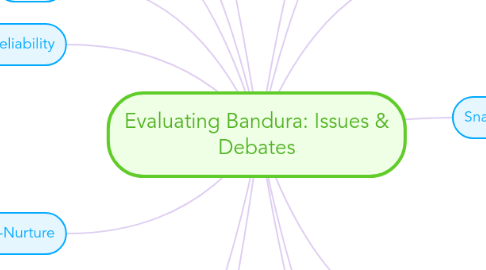Evaluating Bandura: Issues & Debates
저자: Kimberley Croft

1. Ethics
1.1. • consent: having enough information to decide to participate – children themselves didn’t (NB paper provides no indication of parents giving consent)
1.2. • confidentiality: keeping identify of participants secure (although location – Stanford University Nursery School – is known, individuals’ names are not)
1.3. • deception: being lied to about aims or procedures (children not deceived about aim because not told/children deceived in the arousal procedure by telling them the very best toys were for the other children).
2. Ecological Validity
3. Use of Children in Research
4. Validity
5. Reliability
6. Nature-Nurture
6.1. • children imitated the aggression they observed – nurture • children imitated same sex model more – could be influenced by nature or nurture • girls – (somewhat) more verbal imitation – nature as born better linguists (or nurture) • boys – imitated more physical aggression – could be influenced by nature or nurture • aggression existed even in the absence of the model – possibly nature • some new behaviours introduced, e.g. gun – could be nature or nurture • comments on ‘not ladylike’ nurture • needed to be frustrated – nature
6.2. Strengths * Useful to know if behaviour is due to nature/nurture * Improves the status of psychology to address this debate * Children can behave in a very natural manner as they do not understand they are in a study * Can be easy to access children via schools/nurseries/crèches
6.3. Weaknesses * Impossible to test someone who has had no nurturing * Difficult to access children – issues of consent/generalisability * Could be unethical to teach someone aggressive behaviour * Any issues to do with testing children are appropriate * Snapshot studies do not show the learning of behaviour over longer periods of time * Behaviour to be learned should be naturalistic otherwise lacks ecological validity
7. Use of Animals instead
7.1. • animals better because could raise without exposure to any aggressive models so be more sure that effects are due to experimental manipulation; can expose to aggressive models for longer without risk of long-term harmful increase in aggressivenes
7.2. • humans better because researchers able to select models which are likely to be observed; findings will generalise to other children
8. Usefulness & Real Life Applications
8.1. Appropriate comments could include linking application to everyday life to – * Sample used * Qualitative/quantitative data * Social desirability * Scientific nature of the study * Ecological validity * Reductionism * Reliability of the study
8.2. Usefulness; Media, parents, teachers, anyone interested in the wellbeing of children, therapists in prisons to understand why inmates are violent, etc.
9. Quantitative Data
10. Reductionism
10.1. • not reductionist because assessing prior levels of aggression recognises that other factors are at work • cannot conclude whether effects of same sex models are inherently biological or social
10.2. • reductionist because focus is on single cause (imitation) • so excludes other factors both social (e.g. reinforcement, punishment by peers/adults) and nonsocial (e.g. personality, genes) • because experiment was so controlled, e.g. assessing prior levels of aggression and allocating to reduce influence
11. Determinism vs Free-WIll
12. Snapshot study
12.1. • strengths of snapshot studies illustrated by being able to collect data in just a few hours, so each child’s reactions would be very similar, e.g. no differences like wet playtimes making them more aggressive, reducing extraneous variables between observations • also because participants are likely to be similar unlike studies which take a long time when seasonal/generational/cultural differences may influence findings whereas this study’s participants are likely to have all had similar cultural influence, e.g. from trends in violence in TV programmes
12.2. • weaknesses of snapshot studies illustrated by potential lack of generalisibility because situations all similar therefore don’t reflect real variability, e.g. sometimes adults are aggressive so act as models but generally they tell children off for aggression • only one moment in each child’s behavioural stream. Even though they controlled for ‘typical’ aggressiveness by prescreening, some children might have had a “bad morning”.
13. Qualitative Data
13.1. • advantages of qualitative data: e.g. detail/depth e.g. understanding what children thought of aggressive females • don’t miss critical information: e.g. video gives precise record of imitation allowing for analysis of verbal and visual information which might not all be recorded otherwise, so differences between boys and girls should not have been missed
13.2. • disadvantages of qualitative data: gives a narrow view rather than an average one. If only data about, for example, boys’ responses to female aggressive models, were qualitative it would suggest a very gender stereotyped bias against imitating opposite-sex models and although they were less effective, it still happened • hard to quantify therefore compare – this is the case when only qualitative data is recorded or when qualitative data cannot be reduced to quantitative data. This wasn’t the case in Bandura et al.
14. Situational vs Individual explanations
14.1. Situational: Children behave aggressively because they witness the aggressive model and when placed in a similar situation they copy both the physical and verbal aggression. Opposite is true for those in the non-aggressive condition.
15. Generalisations


